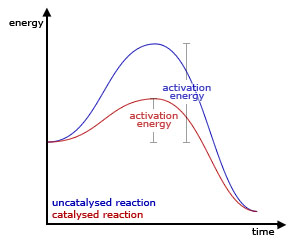catalysts are defined as those substances which alter the rate of reaction by changing the path of reaction. Most of the time a catalyst is used to speed up or increase the rate of the reaction. However, if we go to a deeper level, catalysts are used to break or rebuild the chemical bonds between the atoms which are present in the molecules of different elements or compounds. In essence, catalysts encourage molecules to react and make the whole reaction process easier and efficient.
• A catalyst does not initiate a chemical reaction.
• A catalyst does not be consumed in the reaction.
• Catalysts tend to react with reactants to form intermediates and at the same time facilitate the production of the final reaction product. After the whole process, a catalyst can regenerate.
A catalyst can be either solid, liquid or gaseous catalysts. Some of the solid catalysts include metals or their oxides, including sulphides, and halides. Semi-metallic elements such as boron, aluminum, and silicon are also used as catalysts. Likewise, liquid and gaseous elements which are in pure form are used as catalysts. Sometimes, these elements are also used along with suitable solvents or carriers.
The reaction which involves a catalyst in their system is known as a catalytic reaction. In other words, catalytic action is a chemical reaction between the catalyst and a reactant. This results in the formation of chemical intermediates that can further react quite readily with each other or with another reactant to form a product. However, when the reaction between the chemical intermediates and the reactants occurs or takes place the catalyst is regenerated.
The reaction modes between the catalysts and the reactants usually tend to vary widely and in the case of solid catalysts, it is more complex. Reactions can be acid-base reactions, oxidation-reduction reactions, coordination complexes formation as well as production of free radicals. For solid catalysts, the reaction mechanism is greatly influenced by surface properties and electronic or crystal structures. Some types of solid catalysts such as polyfunctional catalysts can have several reaction modes with the reactants.
